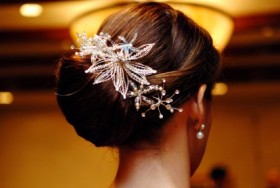Platinum, one of the rarest of precious metals, is found in only a few locations around the world.
Platinum has a rich and noble history. It was first used by the ancient Egyptians about three thousand years ago. Eight hundred years later, the Incas worked with platinum. The first platinum jewelry in Europe appeared around the year 1780, at the court of Louis XVI of France.
Many of the world’s most famous diamonds, including the Hope Diamond, are set in platinum. Carl Faberge’, the famed 19th-century Russian jeweler, prized working in platinum, as did Louis Cartier of Paris and many other great jewelers throughout history.
Platinum is among the finest, purest and rarest precious metals. It has an understated elegance that appeals to both men and women. One of the strongest and most enduring of metals, it is also one of the heaviest. A piece of jewelry containing 90 percent pure platinum weighs 60 percent more than a 14-karat gold piece of similar size. Because it shows little wear, platinum is ideal for jewelry that’s worn everyday. It’s also hypoallergenic and resists tarnish.
Platinum has a high level of purity. In United States, platinum jewelry generally contains anywhere from 85 to 95 percent pure platinum. By comparison, 18-karat gold is 75 percent pure gold and 14-karat gold only 58 percent pure gold.
If a piece of plantium jewelry is marked “Platinum,” it contains at least 95 percent pure platinum. Jewelry with 85 to 95 percent pure platinum is marked “850 Plat.” or “850 Pt.,” or “950 Plat.” or “950 Pt.,” etc.
Jewelry containing at least 50 percent pure platinum and at least 95 percent platinum group metals (palladium, iridium, osmium, rhodium and ruthenium) is marked with the platinum content followed by the content of the other metal. For example: “600 Plat. 350 Irid.” or “600 Pt.350 Ir.”
Jewelry containing less than 50 percent pure platinum content cannot be marked with the word “platinum” or any abbreviation thereof.
Platinum is rare. To produce a single ounce of furnished platinum, a total of 10 tons of ore must be mined. In comparison, only three tons of ore are required to produce one ounce of gold. This rarity gives platinum its cachet.
Platinum is lustrous. Platinum’s rich, white luster complements diamonds and other precious gems, while its neutral color enhances a stone’s brilliance and depth.
Platinum is fashionable. Platinum jewelry appeals to many people today because of its subtle beauty and understated elegance. Many platinum jewelry designs are accented with 18-karat gold, creating a sophisticated, versatile and fashionable look.
Whether you choose a ring, pin, bracelet, earrings, necklace or bridal jewelry, you can find new and sophisticated platinum designs. Some are all platinum for a sophisticated look, but many feature 18-karat gold accents.
As platinum’s pure white luster, strength and durability are recognized and admired, bridal couples worldwide are rediscovering platinum as the metal of choice for engagement, wedding and anniversary jewelry.
A diamond and its setting should last forever. Because platinum is superior to other metals in strength and durability, it offers a diamond the greatest protection. The breathtaking radiance of a diamond fused with the timeless elegance of platinum creates a rare and enduring symbol of love.
Platinum is not the same as white gold: During World War II. the U.S. government prohibited platinum use in non-military applications, including jewelry. Because of strong consumer preference for platinum’s pure white luster, white gold was substituted in platinum’s absence. To create white gold, yellow gold is alloyed with other metals to achieve a white look. However, platinum is white to begin with and maintains its white luster permanently. Its purity, strength, rarity, durability and naturally rich, white color makes it the best choice.
Because of its beauty and value, platinum jewelry has always been given as a special expression of love for engagements, weddings, anniversaries, birthdays and holidays.
Platinum
September 5, 2011 by














Stay in Touch